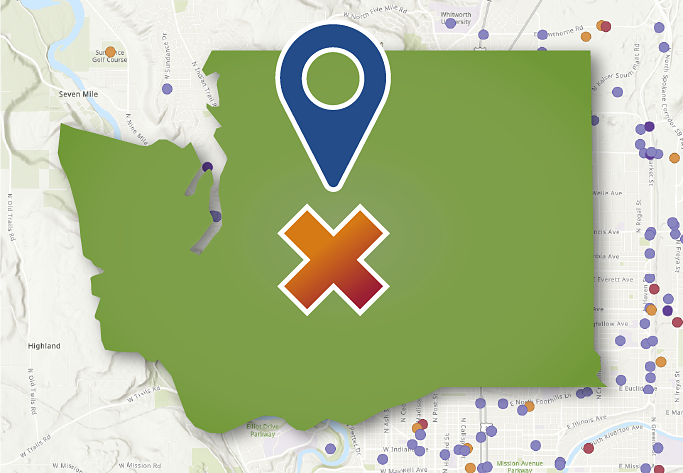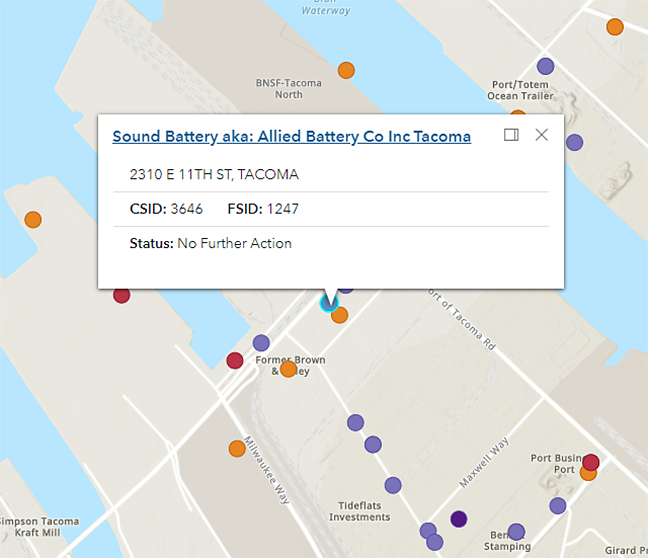
We know of almost 14,000 contamination cleanup sites in Washington state: places where accidents, spills, or industry contaminate the soil, water, or groundwater. Well over half of those sites have already been cleaned up. Still, with that many sites, chances are there’s one somewhere near you.
Since its launch six years ago, Ecology’s What’s in My Neighborhood tool has helped people see if there are cleanup sites near their homes or workplaces. It was time for an update — and while we were at it, we redesigned and expanded the cleanup site webpages, making it easier to get more info about individual cleanup sites.
What’s in your neighborhood?
Clicking a dot displays basic information about a site. Click the site name to go to the cleanup site page and learn a lot more.
What’s In My Neighborhood started with a simple premise: let people see if there are contaminated cleanup sites close to them. That’s still one of the primary uses, but now it’s a lot more powerful. Not only can you search by address or city, you can now search by site name or ID number. The search will find alternate names, too, since site names can change over time. You can also filter your results based on site status, contaminant, and more. For instance, you can see only sites that involve a leaking underground storage tank, or all sites in your county where lead is a concern.
You can see sites in an area by moving and zooming the map, or find sites within a set distance of a specific location using the 'radius' feature.
Ecology's headquarters building at 300 Desmond Drive, Lacey, is within the Tacoma Smelter Plume. There are fifteen cleanup sites within a mile of the building.
The new What’s in My Neighborhood also shows the edges of areas that may have widespread lead and arsenic contamination, either from smelters (like the former Tacoma or Everett ASARCO smelters) or from pesticides sprayed on historic orchards.
By zooming the map out to see the whole state, you’ll see ‘clusters’ showing how many sites are in an area. Zoom in to change the view and see individual sites.
Wait a minute, that’s a lot of dots!
Densely populated or industrial areas may look like we threw confetti at the map — but remember, over half of these sites have already been cleaned up!
Many of the sites that are awaiting cleanup are small and do not pose a big risk to people or the environment: things like leaks from home heating oil tanks. We make sites that do pose immediate risk a high priority, and can enforce immediate cleanup actions before going through the full cleanup process. These are called 'interim actions’ and can deal with the most pressing needs. Some sites marked ‘cleanup started’ might already have had a lot of ‘interim action’ work done.
We don’t mark a site as complete and needing ‘no further action’ until we’re certain it meets the standards in Washington’s cleanup law. Contamination cleanup is complex, and Ecology’s goal is to make sure cleanups permanently protect human health and the environment. That can mean years spent studying a site and exploring different cleanup options, to make sure that all the contamination is addressed for the long term.
Cleanup site pages
The new cleanup site pages provide more information than the old ones, adding extra information from the database we use to track site cleanups. Links to electronic documents associated with the site are now right on the page. You can also see at a glance if there are restrictions on how the site is used, what the suspected or confirmed contaminants are, and whether it’s enrolled in the Voluntary Cleanup Program or has received public Brownfields funding. It’s all in one place on the cleanup site page.
Tell us what you think
We are always looking for feedback and trying to improve our tools. If you have technical issues, questions, or suggestions, please send us an email at TCPWebmail@ecy.wa.gov.





